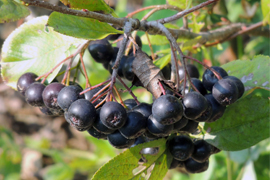
UMaine Extension Researching Market Potential of Antioxidant-Rich Aronia Berry
A small, tart black chokeberry common in the Midwest and Northeast United States that has been recognized for its high levels of antioxidants and nutraceutical properties could become a promising new niche crop for Maine farmers as the result of work by a University of Maine agricultural researcher and colleagues.
University of Maine Cooperative Extension ornamental horticulturist Lois Berg Stack and colleagues at the University of Connecticut are in the second year of a three-year, U.S. Department of Agriculture-funded project to enhance production, growth and processing of the aronia berry. The researchers have been introducing the aronia berry to small farms in New England, including a trial garden at Western Maine Nurseries in Fryeburg, Maine, as a potential new cash crop. Stack says other farmers also are considering cultivating aronia berries and some already are experimenting with a few plants for evaluation.
Stack says the Aronia melanocarpa has almost four times the capacity to neutralize cell-damaging free radicals as wild blueberries and almost three times that of the Central and South American acai berry, one of the latest superfruits on the market. Compared with antioxidant-rich blueberries, cranberries, pomegranate and acai, Stack adds, the aronia berry “blows them out of the water with antioxidants.”
A cold-hardy ornamental bush with a sour fruit, the aronia berry is easy to grow and has few natural pests. With sweeteners added, the berries can be made into nutritional juice drinks, jams and jellies, or consumed in pill form, according to Stack, who is also a UMaine professor of sustainable agriculture. The aronia berry also can be used as a dye because it is high in anthocyanins, a color pigment.
Stack is organizing public outreach efforts to raise awareness about the potential of the berry as a new crop. UConn professor of horticulture Mark Brand is identifying naturally occurring black chokeberries from a variety of states hoping to establish a breeding program to enhance aronia productivity and increase its antioxidant levels.
In August, Stack and Brand discussed aronia berries and their market potential with prospective growers during agricultural field days in Connecticut and in Monmouth, Maine.
“We think the people who might succeed are smaller pick-your-own farms or farms that have more of a community,” says Stack.
Funding for the research and a public awareness campaign comes from a $150,000 Northeast Sustainable Agriculture Research and Education (SARE) grant to UConn. UMaine received about $25,000 for its educational role.
Stack says inroads already made with local farmers willing to cultivate chokeberries are expected to result in growth of the aronia berry harvest next year. Researchers also are working to establish best planting and management practices, calculating the market potential of an aronia berry crop, and determining ways to process and sell aronia berry products.
For more information about UMaine Extension’s aronia berry project, go to umaine.edu/agriculture/home/aronia.
Contact: George Manlove, (207) 581-3756
